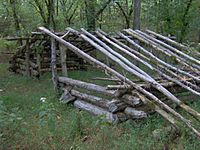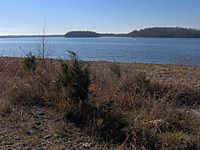Longhunter facts for kids
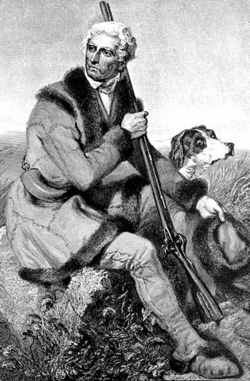
Daniel Boone, one of the most famous longhunters, on the early American frontier
|
|
| Occupation | |
|---|---|
| Names | Longhunter, long hunter |
| Description | |
| Competencies | Trapping, hunting, fishing, skinning, marksmanship, self-defense, trading, canoeing, horsemanship, tracking, exploring, mental and physical toughness, wilderness survival skills, folk medicine, frontier doctoring, diplomacy, English, French, Spanish, and Native American languages |
|
Related jobs
|
Coureur des bois, Mountain man |
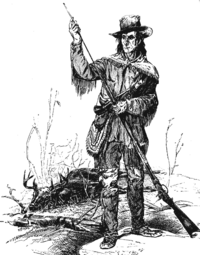
A longhunter was a brave explorer and hunter from the 1700s. These adventurers went on long trips, sometimes for six months, into the wild American frontier. Many of these long trips started in a specific part of Southwest Virginia. The hunters often lived in this area or nearby, in the Clinch River valley.
These groups were usually small, with only two or three men. They typically started their hunts in October and finished in March or April. They traveled west into areas that are now Kentucky and Tennessee. These lands were the homeland of the Cherokee people.
Longhunters gathered important information about these new lands in the 1760s and 1770s. This information was very helpful for early European-American settlers. Many longhunters worked for land surveyors. These surveyors wanted to claim new lands that Great Britain received from France after the Seven Years' War. Some longhunters later helped guide settlers to what became Middle Tennessee and southeastern Kentucky.
Contents
Longhunters in Tennessee History
As more people settled near the Appalachian Mountains in the early 1700s, it became harder to find wild game. Traders who visited Overhill Cherokee villages in the Tennessee Valley reported that there was plenty of game west of the mountains. So, hunters started joining these trade trips.
In 1748 and 1750, Thomas Walker explored the Holston River valley. He wrote about the Cumberland Gap, a pass that made it easier to reach the Tennessee and Cumberland rivers.
In 1761, Elisha Wallen led the first big long hunt into what is now Tennessee. He set up a camp in Lee County, Virginia. From there, he explored the Clinch and Powell valleys in what is now Hawkins County, Tennessee.
After the Seven Years' War ended in 1763, France gave its land claims east of the Mississippi River to Great Britain. More longhunters began crossing the Appalachians into Tennessee and Kentucky. In 1764, Daniel Boone, Richard Callaway, and Benjamin Cutbirth explored the upper Holston Valley. They worked for Richard Henderson, who bought and sold land. One of their camps was later used by William Bean, who built a cabin there around 1769. He was the first known permanent European-American settler in Tennessee.
In 1763, King George III made a rule. It said colonists could not get animal furs from Cherokee lands without a special license. This rule was hard to enforce. In 1769, Cherokee Chief Oconastota complained that the Cherokee Nation was "filling with Hunters." While some longhunters had their furs taken, most avoided being caught.
In 1766, James Smith led a long hunt into Middle and West Tennessee, and Kentucky. He followed the Cumberland River all the way to where it meets the Ohio River. During this trip, a hunter named Uriah Stone had his furs stolen along a river. That river was later named Stones River.
Stone returned to the Cumberland valley in 1769 with other hunters like Kasper Mansker and Isaac and Abraham Bledsoe. These expeditions helped map out trails, salt licks, and camping spots. This information later guided the first settlers to the Middle Tennessee area.
Longhunter Legacy in Tennessee
Many places in Tennessee are named after longhunters. Walden Ridge, a part of the Cumberland Plateau, is named for Elisha Wallen. A high school and many other places are named for Daniel Boone. His adventures became a symbol of frontier life.
Isaac Bledsoe gave his name to Bledsoe Creek in Sumner County, Tennessee. This is now Bledsoe Creek State Park. Isaac's brother, Anthony, later became the namesake for Bledsoe County.
In 1780, Kasper Mansker built a frontier station in what is now Goodlettsville, near Nashville. In 1986, Goodlettsville built a copy of Mansker's Station. It is now open to the public. In the 1970s, the state of Tennessee created Long Hunter State Park. This park is near the J. Percy Priest Lake, where Uriah Stone had his furs stolen.
Longhunters in Kentucky History
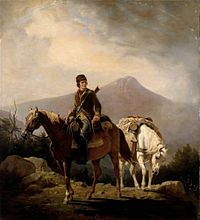
After King George's War ended in 1748, the land between the Appalachian Mountains and the Mississippi River was still being argued over. France wanted the area to connect its lands in Canada with Illinois Country and New Orleans. Great Britain wanted to gain control of the Ohio Valley.
In 1750, Thomas Walker explored what is now southeastern Kentucky. In 1751, explorer Christopher Gist reached the mouth of the Kentucky River. During the French and Indian War, France took control of the Ohio Valley. But when France lost Fort Duquesne in 1758, they had to leave the region. This opened up the area for explorers and hunters from the Thirteen Colonies.
In 1761, part of Elisha Walden's group hunted along the Rockcastle River in Kentucky. In 1767, an expedition led by James Harrod and Michael Holsteiner (Michael Stoner) crossed Kentucky from north to south. They reached the Nashville area. Around the same time, a group led by Benjamin Cutbirth traveled all the way to the Mississippi River. They shipped the furs they collected down to New Orleans.
In 1768, an American explorer named John Finley visited Daniel Boone. Finley told Boone about the beautiful Bluegrass region of Kentucky. The next year, they led a trip into Kentucky. They set up a camp at Red Lick Fork. While Boone and a friend were hunting, they were captured by the Shawnee. Their furs were taken. They returned to their camp to find it robbed. Finley and the rest of the group had gone back to North Carolina.
But Boone and his friend kept hunting. Boone's brother, Squire, later joined him. The Boone brothers stayed in the Kentucky wilderness until 1771. They had their furs taken again by the Cherokee at Cumberland Gap. Still, the Boones wanted to return to settle in the region. Daniel Boone's exciting stories about his hunts encouraged many settlers to come to Kentucky in the years that followed.
Longhunter Legacy in Kentucky
Many places in Kentucky are named after longhunters. Boone County and Boonesborough are named for Daniel Boone. Harrodsburg is named for James Harrod. Kenton County is named for Simon Kenton.
Longhunter James Knox named the Dix River after Cherokee leader Captain Dick. Captain Dick gave Knox permission to hunt along the river in 1770. The U.S. government created Daniel Boone National Forest in 1937 in eastern Kentucky.
Notable Longhunters
- Isaac Bledsoe
- Daniel Boone
- Squire Boone
- Richard Callaway
- Samuel Dale
- John Duff
- James Harrod
- Simon Kenton
- Kasper Mansker
- Henry Skaggs
- James Smith
- Edward Worthington


